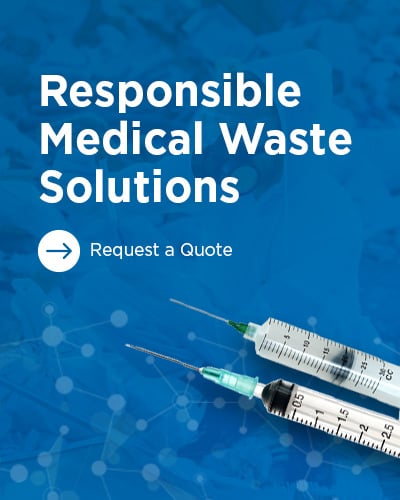Sarah Morrison
Recent Posts
In our most recent article, we discussed the topic of exposure to infectious waste and how to prevent issues that come alongside the disposal of infectious waste. Today, we are going to discuss proper infection control practices, which are once more being brought to the forefront of media attention. From January 1st through March 7th of 2019, we have 228 individual cases of measles that have been confirmed in 12 states, ...
The Occupational Safety and Health Administration (OSHA) has created an incredible number of standards and regulations in order to protect healthcare workers from unnecessary exposure to potentially infectious materials. In 1991, OSHA created the Occupational Exposure to Bloodborne Pathogens Standard. This standard defines regulated medical waste and clarifies basic rules for its disposal. Regulated Medical Waste Defined The ...
The danger of an accidental needlestick looms over healthcare workers and self-injectors daily. If a sharp is handled improperly, it can end up sticking an unintended user, increasing the victim’s risk of exposure to infections. Outside of healthcare facilities, approximately 9 million sharps users will administer at least 3 billion injections annually. Every one of these sharps users will need a place to safely dispose of ...
Before a medical facility can offer care, it has to have an effective method of medical waste disposal in place. But which method is the right one? There are so many guidelines and regulations at play, and the many methods of disposal come with varying price tags, often preventing a facility from aligning with their preference. Maintaining this proper disposal of medical waste is overwhelming. Between labeling, containment, ...
The debate has raged for years: who is at fault when it comes to the rampant prescription drug abuse in our country? There is no easy answer, although plenty of fingers point to the government as the catalyst for our ongoing opioid epidemic. Whatever an individual’s beliefs, it’s evident that steps are now being taken to remedy this situation and move forward. On October 27th of last year, the federal Drug Enforcement ...
In previous articles we have identified the varying types of medical waste produced in medical facilities and some ways of lowering the costs for the disposal of that waste. This article will address hazardous waste specifically, and the regulations surrounding hazardous waste generators. Hazardous waste is defined as waste with “properties that make it dangerous, or capable of having a harmful effect on human health and the ...
Medical waste is generated daily by thousands of facilities across the United States. The World Health Organization (WHO) states that, “Of the total amount of waste generated by health-care activities, about 85% is general, non-hazardous waste comparable to domestic waste. The remaining 15% is considered hazardous material that may be infectious, chemical or radioactive.” Regardless of label, all of that medical waste must ...
Medical waste disposal can be an expensive reality for any facility that handles bio-hazardous materials. Regulations created both by the Occupational Safety and Health Administration (OSHA) and the State identify what materials can be labeled as medical waste, and the over-classification of this waste often leads to a facility overpaying for its disposal. However, there are ways to reduce these costs associated with the ...
Medical waste is a harsh reality for any healthcare facility. Often, that waste becomes hazardous and harmful to humans and the environment. Once that threshold has been crossed, an entirely different set of regulations surrounding its disposal comes into play. Hazardous waste can be found in any physical state; liquid, gaseous, or solid. The type of disposal depends entirely upon the physical state the waste is in, and ...
It is only February, and already the United States has undergone two viral outbreaks in 2019, according to the Centers for Disease Control (CDC). These outbreaks were unnecessary and entirely preventable, proving that there needs to be a stronger emphasis on infection control. Proper infection control needs to be practiced in any facility that utilizes medical instruments or is involved in contact with bodily fluids. In this ...
Category
- sharps disposal (30)
- Medical Waste (28)
- sharps container disposal (25)
- Compliance (20)
- sharps mail back (19)
- Pharmaceutical Waste Disposal (14)
- Infection Control (13)
- Dental Practice (12)
- Safety (12)
- biohazardous waste disposal (11)
- OSHA (9)
- Hazardous Waste (8)
- amalgam disposal (8)
- patient support programs (8)
- Universal Waste (7)
- amalgam separators (6)
- vet sharps disposal (6)
- Hazardous Waste Disposal (5)
- amalgam recycling (5)
- dental clinical waste disposal (5)
- Amalgam (4)
- ECOII Amalgam Separator (4)
- News (4)
- OSHA Training (4)
- #GLP1 (3)
- News & Regulations (3)
- medication disposal (3)
- surface disinfectant (3)
- veterinary medical waste (3)
- HIPAA (2)
- flu vaccine (2)
- influenze (2)
- BioSURF (1)
- HIPAA Compliance (1)
- HIPAA Law (1)
- HIPAA Violation (1)
- RP Returns (1)
- improving patient experience (1)
- quart containers (1)
- sharps disposal for veterinarians (1)















